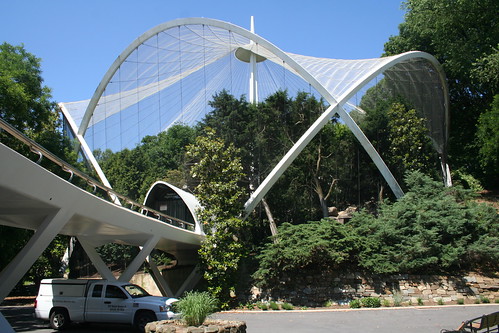There’s not much of it, and it has some rather determined enemies, so when modernism happens or survives in Washington DC, it feels like somewhere between a happy accident and a miracle.
Or maybe it’s just me. It’s taken me five years of visits to the National Zoo–a five minute walk from our place in DC–to open my eyes to the awesome rarity that is the Great Flight Cage.
Not to say I didn’t notice and like it sooner; its functional yet elegant structure is a standout. From the striking arches; to the curved concrete entrance hut and its twin inside, which serves as a coop of some kind; to the struts under the footbridge connecting the aviary to the banal brick box of the Bird House; it feels like an understate, especially successful, early Santiago Calatrava–from the engineering days, before he got so showy.
The Great Flight Cage was finished in what turned out to be a Golden Age of Aviary design, 1964. And yet, does anyone know who designed it? Do we sing their praises? No. Near as I can tell, the architect was Richard Dimon at the firm of Daniel, Mann, Johnson and Mendenhall. DMJM was awarded a major expansion project for the Zoo by the Smithsonian, which included the aviary and remodeling the Bird and Antelope Houses.
But the archives of the Washington Post contain no discussion of the aviary’s architecture, and barely ever acknowledges its existence at all, except to mention its initial cost and its completion. And that silence seems to have echoed beyond DC.
At the same time Dimon was designing the National Zoo’s aviary, Lord Snowdon, Cedric Price, and Frank Newby were finishing the angular Snowdon Aviary at the London Zoo. And Buckminster Fuller was building a large geodesic dome for the New York World’s Fair which would become the aviary for the new Queens Zoo, and which would be dubbed one of the great interior spaces of New York.
As the link above shows, Dimon appears to have left architecture behind and taken up landscape painting. Though his brief bio says he has designed “many buildings” in the Washington DC area, the only ones I can identify are at the zoo. And the only one of those that’s any good is the aviary, and it’s spectacular.
Skip to content
the making of, by greg allen

